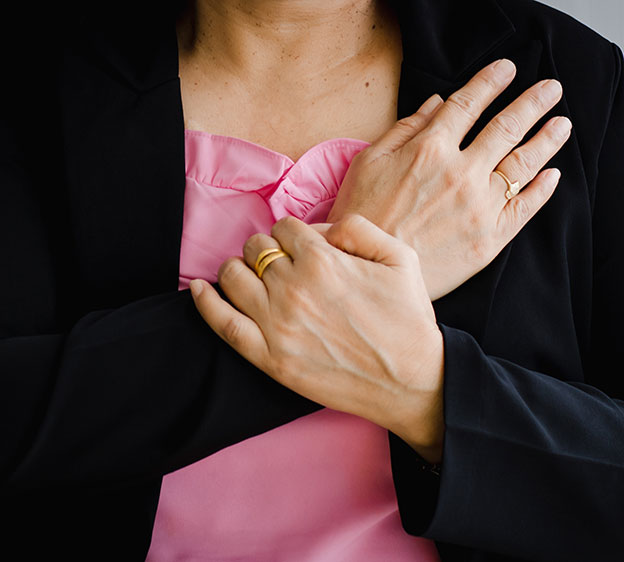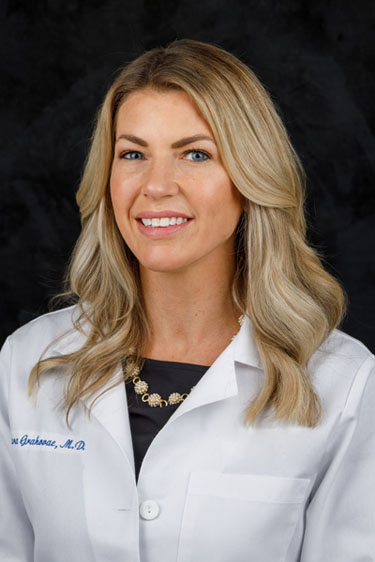
Breast pain, also known as “mastalgia,” is an issue for many women. Though it can be alarming, most cases are not linked to serious health concerns like breast cancer. Breast pain can vary from mild discomfort to intense aches, and understanding the different types of breast pain, potential causes and treatment options available can give you peace of mind.
Types of Breast Pain
Breast pain generally falls into two categories: cyclic breast pain and noncyclic breast pain. Each type is associated with different causes and symptoms. Cyclic breast pain is typically not cause for alarm because it’s associated with regular monthly hormone fluctuations. Noncyclic breast pain is unrelated to hormonal changes and, while rare, can sometimes indicate an underlying issue that needs medical attention. Here’s a breakdown of the two categories:
- Cyclic breast pain: This type of pain is linked to the menstrual cycle and fluctuating hormone levels. It often affects both breasts and tends to worsen in the days leading up to your menstrual period. Cyclic breast pain is more common in younger women and can feel like a dull, heavy ache or tenderness in the breast tissue.
- Noncyclic breast pain: Unlike cyclic pain, noncyclic breast pain is not connected to the menstrual cycle. This type of pain can occur at any time and is often described as sharp or burning. Noncyclic breast pain may be localized to one breast and can result from a variety of factors, such as injury, infection or an underlying condition.
“Breast pain is very common; most women experience breast pain at some point in their life, and it's essential to remember that in the majority of cases, it is not indicative of a serious underlying condition,” says Dr. Tara Grahovac, M.D., FACS, board-certified and fellowship-trained breast surgical oncologist with the Beaufort Memorial Breast Care & Surgery Program. “However, if persistent discomfort arises, seek guidance from a health care provider.”
Read More: Know Your Lemons
Common Causes of Breast Pain
There is no one answer to the question, “Is breast pain normal?” Some of the most common causes include:
- Birth control pills or hormonal replacement therapy: Hormonal contraceptives like birth control pills can sometimes cause breast tenderness or pain as a side effect. If you’ve recently started or changed your birth control or are undergoing hormonal replacement therapy, you may notice changes in your breast sensitivity.
- Breast cancer: Although rare, breast cancer can sometimes cause pain. If you experience persistent, localized pain that is accompanied by other symptoms such as a lump or changes in the breast's appearance, including dimpling, see your health care provider for further evaluation.
- Breast injury: Trauma to the breast, such as a fall or impact, can lead to breast pain. The pain may be immediate or develop over time as the tissues heal.
- Infection: An infection in the milk ducts can cause localized pain, swelling and redness in the breast. This type of infection can cause fever or discharge from your nipple.
- Fibrocystic breast changes: Many women develop fibrocystic breast changes, a noncancerous condition where the breasts feel lumpy or rope-like. These changes can cause both cyclic and noncyclic pain, especially around the time of your period.
- Hormonal changes: Hormone fluctuations during the menstrual cycle are a common cause of cyclic breast pain. Changing levels of estrogen and progesterone can lead to tenderness and swelling in the breast tissue.
Read More: Do Mammograms Hurt?
Symptoms of Breast Pain
Breast pain can feel different depending on the person. Common symptoms and experiences include:
- Aching or heaviness that may spread to the underarm area.
- Discomfort that worsens before or during your menstrual period
- Sharp or burning pain, typically associated with noncyclic breast pain.
- Swelling or fullness in the breasts.
- Tenderness or soreness in one or both breasts.
Not everyone experiences breast pain the same, Dr. Grahovac says, and there’s no one version of breast pain that’s worse than another.
“You should be performing routine breast self-exams in addition to talking to your provider and having an annual mammogram if you’re of screening age – age 40 and older,” Dr. Grahovac says. “If you’re on top of your breast health, you can identify symptoms that are abnormal for you.”
When to Talk to a Provider
While breast pain is usually not a cause for concern, there are instances when you should consult a provider. Your provider may recommend mammograms or other tests to rule out serious conditions. Contact a provider if:
- There is discharge from your nipple (especially if it’s bloody or occurs without squeezing).
- You have signs of an infection, such as redness, warmth or fever.
- You notice a lump or change in the shape of your breast.
Or, Dr. Grahovac says, you may want to contact a provider if your symptoms are concerning to you. Breast pain can have many causes, and no matter what your symptoms are, if you’re concerned, talking with your doctor is a good next step.
Read More: Take Control of Your Breast Cancer Risk Factors
Lifestyle Adjustments for Breast Pain
While the causes of breast pain are wide-ranging, there isn’t any one particular fix. There are, however, several tips that can help you relieve symptoms.
- Apply a warm or cold compress to the affected area to ease discomfort.
- Dress in layers to accommodate changes in body temperature.
- Remember that preventive care is self-care. Get your annual mammogram to rule out some of the issues that could be causing breast pain.
- Wear a well-fitting, supportive bra to reduce strain on your breast tissue.
Treatments for Breast Pain
Treatment for breast pain depends on the underlying cause. Your provider will work with you and help you determine the best plan of care. There are medications and holistic remedies that can help:
- Birth control pills: If hormonal fluctuations are the root cause of your breast pain, your doctor may recommend birth control pills to regulate hormone levels and reduce symptoms. However, for some women, hormonal contraceptives can exacerbate breast pain as a side effect, so it’s important to discuss this with your doctor.
- Over-the-counter pain relievers: Ibuprofen or acetaminophen can be helpful in managing discomfort. These medications are especially useful for short-term relief of pain associated with cyclic breast pain.
- Natural remedies: Some women find relief from breast pain with natural remedies, such as vitamin E supplements. Other options, like evening primrose oil or fish oil supplements, contain essential fatty acids that may help. While research on their effectiveness is limited, these options may be worth discussing with your doctor.
- Prescription medications: In some cases, prescription medications such as hormonal treatments may be used to manage chronic breast pain. These are typically prescribed for women with severe breast pain who do not respond to over-the-counter medications or lifestyle changes.
Read More: Screening vs. Diagnostic Mammogram: What’s the Difference?
Breast Pain: Seeking Medical Help
Breast pain can be an uncomfortable and sometimes worrisome condition, but in most cases, it’s not a sign of something serious.
In addition, keep in mind that regular mammograms make it possible for you and your providers to stay on top of any concerns about your breast health or breast pain.
“If a mammogram shows any issues, they can most likely be addressed early if your scans are yearly,” Dr. Grahovac says. “Early detection and intervention of breast cancer generally means a better chance at a full recovery.”
Breast pain — while sometimes scary — is often not related to serious underlying conditions but can be a good reminder to readdress your breast health with your primary care provider.

